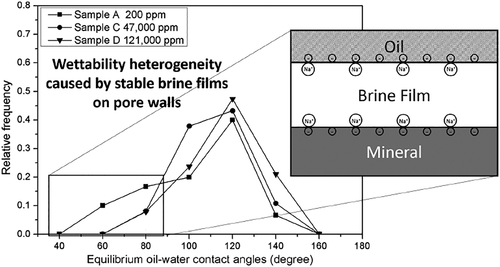当前位置:
X-MOL 学术
›
Energy Fuels
›
论文详情
Our official English website, www.x-mol.net, welcomes your
feedback! (Note: you will need to create a separate account there.)
Impact of Connate Brine Chemistry on In Situ Wettability and Oil Recovery: Pore-Scale Experimental Investigation
Energy & Fuels ( IF 5.2 ) Pub Date : 2020-03-09 , DOI: 10.1021/acs.energyfuels.9b03787 Yun Xie 1 , Mahdi Khishvand 1 , Mohammad Piri 1
Energy & Fuels ( IF 5.2 ) Pub Date : 2020-03-09 , DOI: 10.1021/acs.energyfuels.9b03787 Yun Xie 1 , Mahdi Khishvand 1 , Mohammad Piri 1
Affiliation

|
In this study, we present the results of micro- and macroscale core-flooding experiments performed on reservoir and outcrop sandstone core samples to investigate the impact of connate brine salinity on wettability and oil recovery. Numerous core samples were fully saturated with connate brines of varying salinities and then subjected to a dynamic wettability restoration (aging) process. The miniature core samples were imaged at high resolutions, and the images were used to measure in situ contact angles and evaluate the wettability alteration. Subsequently, some of the core samples were flooded with identical injection brine to examine the interrelationship between connate brine salinity and oil recovery potentials. The experimental observations demonstrate an ascending trend of initial oil–water contact angles with increases in brine salinity. We believe that brine film thickness, controlled by the DLVO interactions and initial cation-water bridging, is responsible for this wettability sensitivity. The equilibrium wettability state is found to shift toward reduced water-wetness when the connate brine salinity increases, which could be associated with improved oil−mineral bonding at higher salinities. Furthermore, using an ultralow salinity connate brine in the aging process results in a heterogeneous equilibrium wettability state including 46% of weakly water- and neutral-wet pores. It is believed that the ultralow salinity brine preserves stable brine films on some of the pore walls, prevents direct oil−mineral contact, and consequently reduces the degree of wettability alteration during the aging process. The subsequent waterflooding experiments on the aged samples indicated favorable oil recovery from media with heterogeneous equilibrium wettability compared to the weakly oil-wet samples. This was due to the existence of water- and neutral-wet pores that reduced the entry pressures of water-displacing-oil events and enhanced the accessibility of water to the oil-wet pore elements, which in turn improved the oil displacement efficiency.
中文翻译:

天然卤水化学对原位润湿性和采油率的影响:孔隙度实验研究
在这项研究中,我们介绍了在储层和露头砂岩岩心样品上进行的微观和大规模岩心驱油实验的结果,以研究原生盐水盐度对润湿性和采油率的影响。许多岩心样品被不同盐度的原生盐水完全饱和,然后进行动态润湿性恢复(老化)过程。对微型岩心样品进行高分辨率成像,然后将这些图像用于测量原位接触角并评估润湿性变化。随后,将一些岩心样品注入相同的注入盐水,以检查原生盐水盐度与采油潜力之间的相互关系。实验观察表明,随着盐水盐度的增加,初始油水接触角呈上升趋势。我们认为,由DLVO相互作用和初始的阳离子-水桥联控制的盐水膜厚度是造成这种润湿敏感性的原因。当天然盐水的盐度增加时,平衡润湿性状态会朝着降低的水润湿性转变,这可能与较高盐度下改善的油-矿结合有关。此外,在老化过程中使用超低盐度原生盐水会导致非均质的平衡润湿性状态,其中包括46%的弱水和中性湿孔。可以相信,超低盐度盐水在某些孔壁上保持了稳定的盐水膜,防止了油与矿物的直接接触,因此降低了老化过程中润湿性变化的程度。随后对老化样品进行的注水实验表明,与弱油湿样品相比,从具有非均质平衡润湿性的介质中有利地采收了油。这是由于存在水和中性湿孔隙,这些孔隙降低了驱油事件的进入压力,并增加了水进入油湿孔隙元素的通道,进而提高了驱油效率。
更新日期:2020-04-23
中文翻译:

天然卤水化学对原位润湿性和采油率的影响:孔隙度实验研究
在这项研究中,我们介绍了在储层和露头砂岩岩心样品上进行的微观和大规模岩心驱油实验的结果,以研究原生盐水盐度对润湿性和采油率的影响。许多岩心样品被不同盐度的原生盐水完全饱和,然后进行动态润湿性恢复(老化)过程。对微型岩心样品进行高分辨率成像,然后将这些图像用于测量原位接触角并评估润湿性变化。随后,将一些岩心样品注入相同的注入盐水,以检查原生盐水盐度与采油潜力之间的相互关系。实验观察表明,随着盐水盐度的增加,初始油水接触角呈上升趋势。我们认为,由DLVO相互作用和初始的阳离子-水桥联控制的盐水膜厚度是造成这种润湿敏感性的原因。当天然盐水的盐度增加时,平衡润湿性状态会朝着降低的水润湿性转变,这可能与较高盐度下改善的油-矿结合有关。此外,在老化过程中使用超低盐度原生盐水会导致非均质的平衡润湿性状态,其中包括46%的弱水和中性湿孔。可以相信,超低盐度盐水在某些孔壁上保持了稳定的盐水膜,防止了油与矿物的直接接触,因此降低了老化过程中润湿性变化的程度。随后对老化样品进行的注水实验表明,与弱油湿样品相比,从具有非均质平衡润湿性的介质中有利地采收了油。这是由于存在水和中性湿孔隙,这些孔隙降低了驱油事件的进入压力,并增加了水进入油湿孔隙元素的通道,进而提高了驱油效率。











































 京公网安备 11010802027423号
京公网安备 11010802027423号